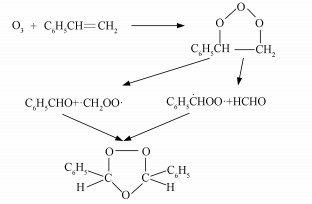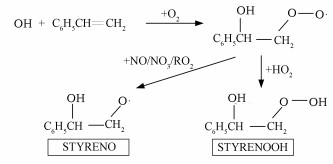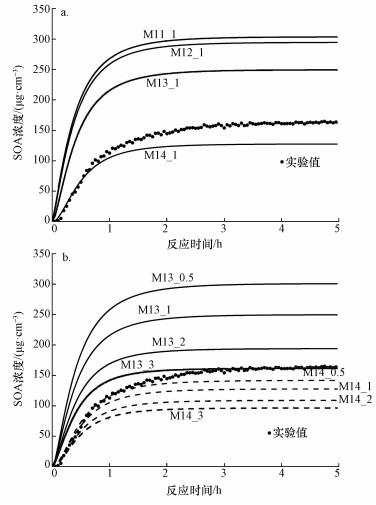2. 中国科学技术大学, 合肥 230026;
3. 中国科学技术大学环境科学与光电技术学院, 合肥 230026
2. University of Science and Technology of China, Hefei 230026;
3. School of Environmental Science and Optoelectronic Technology, University of Science and Technology of China, Hefei 230026
苯乙烯(C8H8)是一种高反应活性的烯烃, 其在大气中的浓度约为0.06~45 ppb (贾记红等, 2009; Cho et al., 2014; 区家敏等, 2014), 主要来源于人为源排放, 包括机动车尾气排放、石油加工、黏合剂挥发等(ATSDR, 2010; Uhde et al., 2007; 王伯光等, 2008).由于苯乙烯具有潜在的致癌和致突变特性, 若长时间或高浓度的暴露, 会对中枢神经系统和生殖系统造成损害.另外, 苯乙烯在大气中易被氧化剂(如臭氧O3、羟基自由基·OH、硝酸基自由基NO3·)氧化, 生成二次有机气溶胶(Secondary Organic Aerosol, SOA), 导致二次污染(王跃思等, 2010; 贾龙等, 2010; Wang et al., 2015).
与臭氧启动的其它烯烃的氧化机理类似, O3先通过1, 3-环加成至苯乙烯分子的C=C双键上, 生成不稳定的初级臭氧化物(Primary Ozonide, POZ), 随后分解成一种羰基氧化物(也称Criegee中间体)和一种醛(Criegee et al., 1949).Criegee中间体可与H2O、NO、NO2、SO2等发生双分子反应(Anglada et al., 2011; 2016;Lin et al., 2014; Long et al., 2011; 2016;Stone et al., 2014; Vereecken et al., 2012).大量研究表明, Criegee中间体会重新与醛类反应生成含五元环的次级臭氧化物(Secondary Ozonide, SOZ) (Fajgar et al., 1996; Griesbaum et al., 1998; Horie et al., 1999; Jalan et al., 2013; Neeb et al., 1996; Wei et al., 2015).图 1为Tuazon等(1993)提出的苯乙烯与O3反应生成SOZ的机理, 苯乙烯与臭氧反应生成的初级臭氧化物分解为两种Criegee中间体(C6H5HOO·与·CH2OO·)和两种醛(C6H5CHO与HCHO), 其中, C6H5HOO·可再与C6H5CHO反应生成次级臭氧化物3, 5-二苯基-1, 2, 4-三氧戊环, 该SOZ在室温下呈固态(NIST Chemistry WebBook, 2018), 极低的饱和蒸气压(5.9×10-8 Torr)使其极易通过气-粒转化进入气溶胶相(Na et al., 2006), 成为最终SOA产物的重要组分.
 |
| 图 1 苯乙烯与臭氧反应生成SOZ的反应机理 Fig. 1 Reaction mechanism of styrene reacting with ozone to generate SOZ |
在烯烃臭氧化反应中, 会伴随着大量·OH的产生, 这些·OH会与母体分子发生反应, 或与产物反应发生二次氧化, 使得反应变得更复杂(Iinuma et al., 2005; Jonsson et al., 2008).为了减少二次氧化的影响, 很多研究中都会加入·OH清除剂, 比如仲丁醇(Chew et al., 1996; 李时政等, 2015; Yuan et al., 2017)、环己烷(Gai et al., 2009; Li et al., 2016; Wu et al., 2017)或CO(Gutbrod et al., 1997).有无·OH清除剂的存在会对烯烃的臭氧化反应机理产生不同的影响(Jenkin, 2004).本文通过烟雾箱实验研究仲丁醇对苯乙烯臭氧化反应生成SOA的影响, 并结合箱式模型分析这一影响的背后机制.最后通过敏感性分析探索Criegee中间体与醛的反应速率对生成SOA产率的影响.
2 材料与方法(Materials and methods) 2.1 烟雾箱实验苯乙烯(纯度为99%)、仲丁醇(纯度为99%)购自Sigma-Aldrich公司.实验中使用的背景气体为AADCO零空气发生系统(Model 737)产生的零空气.
自制室内6 m3烟雾箱系统的主反应器由Teflon材料制成, 位于绝热材料制成的壳体内部.实验前将苯乙烯和仲丁醇先后通过微量注射器注入到250 mL的加热玻璃瓶中(瓶内温度维持在约100 ℃), 随后通过零空气吹扫入烟雾箱反应器中.反应器内物质充分混匀后, 将臭氧发生器(COM-AD-01)产生的O3通入反应器并再次摇晃反应器使其充分混合.苯乙烯浓度使用美国Agilent公司的气相色谱仪(GC-FID, Agilent 7820A)测量, O3浓度使用美国Thermo公司的O3分析仪(Model 49i)测量, 生成的SOA质量浓度采用成套的SMPS仪器(Scanning Mobility Particle Sizer, SMPS 3936)进行测量.所有实验均在(25±1) ℃、相对湿度小于5 %的黑暗条件下进行.
2.2 数值模拟零维箱式模型用来模拟苯乙烯与臭氧反应生成SOA的过程.气相机理使用英国Leeds大学开发的MCM v3.3.1 (http://mcm.leeds.ac.uk/MCM), 其苯乙烯和仲丁醇的子机理共包括245个化学物质和730个反应.由于在该体系中, Criegee中间体与醛的反应对SOA的生成有着重要贡献(Tuazon et al., 1993; Na et al., 2006), 因此, 反应(1)~(4)被添加到箱式模型中.

|
(1) |

|
(2) |

|
(3) |

|
(4) |
剔除苯乙烯氧化过程中生成的过氧自由基、烷氧自由基等寿命极短的中间体后, 共有91个稳定物质参与气-粒分配过程的计算.其中9个物质在NIST标准参考数据库(https://webbook.nist.gov/chemistry/)中有实验测得的饱和蒸气压值, SOZ1的饱和蒸气压使用Na等(2006)计算得到的值(5.9×10-8 Torr), 其余物质的饱和蒸气压通过在线模型UManSysProp v1.0计算得到(Topping et al., 2016).该模型选择的沸点计算方法和蒸气压计算方法分别来自文献(Nannoolal et al., 2004; 2008).气-粒分配模型最初由Pankow(1994)提出, 对箱式模型中的物质不断计算其在气相中的反应导致的浓度变化, 以及依据气-粒分配理论在气相和气溶胶相之间的分配, 各物质在气溶胶相内的反应没有考虑在本模型中.
3 结果与讨论(Results and discussion) 3.1 烟雾箱实验结果各实验的初始条件及SOA产率如表 1所示.实验共分两组进行, A组在无仲丁醇条件下进行, B组在过量仲丁醇条件下进行, 仲丁醇的初始浓度约为苯乙烯的50倍.为了使苯乙烯氧化完全, 所有实验在臭氧过量的条件下进行, [O3]0/[苯乙烯]0为2~4. SOA产率(Y)定义为生成的SOA质量浓度([SOA], μg·m-3)与消耗的碳氢化合物浓度(△[HC], μg·m-3)之比(式(5))(Odum et al., 1996; Pankow, 1994).

|
(5) |
在反应刚开始时生成的颗粒物体积较小, 随着反应的进行其体积逐渐增大.反应生成的气溶胶由于壁效应的存在浓度逐渐下降, 对其壁损耗校正的方法已在其它文献中详述(Hu et al., 2017).对所有实验都进行壁效应校正后, 仲丁醇对SOA产率的影响如图 2所示, 图中曲线为使用双产物法拟合相应产率数值得到的产率曲线(Odum et al., 1996; 陈文泰等, 2012).可以看出, 在仲丁醇存在的情况下, 苯乙烯臭氧化反应生成SOA的产率明显下降.这一现象与单萜烯和倍半萜烯类物质生成SOA的实验结果一致(Docherty et al., 2003; Jenkin, 2004; Jonsson et al., 2008).
 |
| 图 2 无仲丁醇和过量仲丁醇条件下苯乙烯臭氧化反应生成的SOA产率 Fig. 2 The yield of SOA produced by ozonolysis of styrene in the absence and presence of 2-butanol |
| 表 1 实验的初始条件和最终的SOA产率 Table 1 Initial conditions and final SOA yields of chamber experiments |
Taatjes等(2012)通过实验中对·CH2OO·的直接测量, 得到·CH2OO·+CH3CHO反应在4 Torr条件下的绝对速率常数为(9.4±0.7)×10-13 cm3·molecule-1·s-1.另外在Stone等(2014)的实验中, 上述反应速率在低压极限条件下约为1.6×10-29 cm3·molecule-1·s-1, 而高压极限条件下约为1.7×10-12 cm3·molecule-1·s-1. MCM v3.3.1机理中尚不包括Criegee中间体与醛类的反应, 且反应(1)~(4)的速率常数缺乏直接的实验数据, 本文将反应(1)~(4)和k1=k2=k3=k4=1.0×10-13 cm3·molecule-1·s-1加入到箱式模型中, 以探索这类反应在SOA生成中所起的作用.以实验A3和B8为例, 烟雾箱实验和数值模拟结果对比如图 3所示.在本模拟条件下, 苯乙烯与实验值基本吻合, 臭氧浓度略高于实验值, 最终的SOA产率比实验值高出约50%.说明MCM v3.3.1机理基本上能重现苯乙烯与臭氧反应的气相过程.
 |
| 图 3 实验A3(a)和B8(b)反应过程中实验测量和数值模拟结果对比 (图中点代表实验测量值, 曲线代表对应物质的模拟值) Fig. 3 Experimental and simulation results during the experiment A3(a) and B8(b) (The points represent the experimental results, and the lines represent the corresponding simulated values) |
对不同模拟条件下得到的气溶胶成分进行分析, 在没有加入仲丁醇作为·OH清除剂的情况下, 其主要SOA成分为3, 5-二苯基-1, 2, 4-三氧戊环(SOZ1)和2-过氧化氢基-1-苯基乙醇(STYRENOOH)(表 2), 均占到总SOA质量的1/2左右.STYRENOOH在MCM v3.3.1中生成路径如图 4所示, 在苯乙烯与臭氧反应过程中产生的·OH再与苯乙烯反应产生STYRENOOH, 并大量进入气溶胶相.当加入过量仲丁醇作为·OH清除剂后([仲丁醇]0/[苯乙烯]0约为70), 过量的仲丁醇消耗了大量的·OH, 使后者浓度下降了约50倍.这样更多的苯乙烯被O3所氧化, 而更少的苯乙烯被·OH氧化, 导致STYRENOOH产率的降低, 最终SOA产率也随之下降.另外, 仲丁醇的存在导致HO2浓度上升和RO2浓度下降.在对α-蒎烯和β-蒎烯等烯烃与O3反应的研究中也发现, ·OH清除剂的加入会引起[HO2]/[RO2]比的明显上升, 导致形成更多挥发性更强的产物, 进而影响了SOA的形成机制(Docherty et al., 2003; Jenkin, 2004; 兰辉等, 2011; Yuan et al., 2017).
| 表 2 不同模拟条件下得到的不同产物浓度 Table 2 Several product concentrations obtained under different simulation conditions |
 |
| 图 4 MCM v3.3.1中STYRENOOH的生成路径 Fig. 4 STYRENOOH generation path in MCM v3.3.1 |
由于添加到箱式模型中的Criegee中间体与醛类反应的速率常数存在很大的不确定性, 因此, 针对这些速率常数对SOA生成的敏感性进行了分析.模拟条件如表 3所示, 其它初始条件同实验A3.模拟主要分两组展开, 第1组假设反应(1)~(4)的速率常数均相同, 第2组假设反应(1)~(4)的速率常数随着苯环官能团的增多而逐渐减小或增大.
| 表 3 箱式模型中使用的速率常数 Table 3 Rate constants used in box model |
模拟结果如图 5所示, 图中黑色圆点为实验A3中所测得的SOA质量浓度.在假设k1=k2=k3=k4的情况下(图 5a), 随着Criegee中间体与醛类反应速率常数的增大, 该类反应的重要性逐渐增大, 得到SOZ产率增高, 同时生成的SOA质量浓度也越高; 而随着反应(2)~(4)反应速率相对于反应(1)的增大(图 5b), ·CH2OO·和HCHO与反应C6H5ĊHOO·+C6H5CHO→SOZ1产生更强的竞争反应, 得到的SOA质量浓度越低.模拟结果表明,反应(1)~(4)的反应速率对最终SOA形成有重要影响, 因此, 这一类反应的动力学研究有待进一步开展.
 |
| 图 5 Criegee中间体与醛类反应的不同速率常数对模拟结果的影响 Fig. 5 Effects of the rate constants of Criegee intermediates and aldehydes on simulation results |
1) 过量仲丁醇的存在消耗了苯乙烯与臭氧反应产生的大量·OH, 影响了其中的自由基反应过程, 导致生成的SOA产率下降.
2) MCM v3.3.1气相化学机理能较好地重现烟雾箱中苯乙烯与臭氧的消耗速率,将速率系数为1.0×10-13 cm3·molecule-1·s-1的Criegee中间体+醛→SOZ反应添加到箱式模型后, 模拟得到的SOA产率较实验值高约50%, 且得到的产物主要为3, 5-二苯基-1, 2, 4-三氧戊环和2-过氧化氢基-1-苯基乙醇.
3) 针对Criegee中间体与醛反应在箱式模型中的影响进行了敏感性分析, 该反应对于苯乙烯与臭氧反应生成SOA的过程有着重要影响.但其反应速率系数缺乏直接的实验值和精确的理论值, 这些有待进一步的研究.
Anglada J M, Gonzalez J, Torrent-Sucarrat M. 2011. Effects of the substituents on the reactivity of carbonyl oxides.A theoretical study on the reaction of substituted carbonyl oxides with water[J]. Physical Chemistry Chemical Physics, 13(28): 13034–13045.
DOI:10.1039/c1cp20872a
|
Anglada J M, Sole A. 2016. Impact of the water dimer on the atmospheric reactivity of carbonyl oxides[J]. Physical Chemistry Chemical Physics, 18(26): 17698–17712.
DOI:10.1039/C6CP02531E
|
Agency for Toxic Substances and Disease Registry(ATSDR). 2010. Toxicological profile for styrene[OL]. 2018-03-21. https://www.atsdr.cdc.gov/toxprofiles/tp.asp?id=421&tid=74.
|
陈文泰, 邵敏, 袁斌, 等. 2013. 大气中挥发性有机物(VOCs)对二次有机气溶胶(SOA)生成贡献的参数化估算[J]. 环境科学学报, 2013, 33(1): 163–172.
|
Chew A A, Atkinson R. 1996. OH radical formation yields from the gas-phase reactions of O3 with alkenes and monoterpenes[J]. Journal of Geophysical Research:Atmospheres, 101(D22): 28649–28653.
DOI:10.1029/96JD02722
|
Cho J, Roueintan M, Li Z. 2014. Kinetic and dynamic investigations of OH reaction with styrene[J]. The Journal of Physical Chemistry A, 118(40): 9460–9470.
DOI:10.1021/jp501380j
|
Criegee R, Wenner G. 1949. Die ozonisierung des 9, 10-oktalins[J]. Justus Liebigs Annalen der Chemie, 564(1): 9–15.
DOI:10.1002/(ISSN)1099-0690
|
Docherty K S, Ziemann P J. 2003. Effects of stabilized criegee intermediate and OH radical scavengers on aerosol formation from reactions of β-Pinene with O3[J]. Aerosol Science and Technology, 37(11): 877–891.
DOI:10.1080/02786820300930
|
Fajgar R, Vítek J, Haas Y, et al. 1996. Observation of secondary 2-butene ozonide in the ozonation of trans-2-butene in the gas phase[J]. Tetrahedron Letters, 37(19): 3391–3394.
DOI:10.1016/0040-4039(96)00554-0
|
Gai Y B, Ge M F, Wang W G. 2009. Rate constants for the gas phase reaction of ozone with n-butyl acrylate and ethyl methacrylate[J]. Chemical Physics Letters, 473: 57–60.
DOI:10.1016/j.cplett.2009.03.070
|
Griesbaum K, Miclaus V, Jung I C. 1998. Isolation of ozonides from gas-phase ozonolyses of terpenes[J]. Environmental Science & Technology, 32(5): 647–649.
|
Gutbrod R, Meyer S, Rahman M M, et al. 1997. On the use of CO as scavenger for OH radicals in the ozonolysis of simple alkenes and isoprene[J]. International Journal of Chemical Kinetics, 29(9): 717–723.
DOI:10.1002/(ISSN)1097-4601
|
Horie O, Schäfer C, Moortgat G K. 1999. High reactivity of hexafluoro acetone toward criegee intermediates in the gas-phase ozonolysis of simple alkenes[J]. International Journal of Chemical Kinetics, 31(4): 261–269.
DOI:10.1002/(ISSN)1097-4601
|
Hu C, Ma Q, Liu Z, et al. 2017. Influence of NO2 on secondary organic aerosol formation from ozonolysis of limonene[J]. Atmospheric Chemistry & Physics, 2017: 1–58.
|
Iinuma Y, Boge O, Miao Y, et al. 2005. Laboratory studies on secondary organic aerosol formation from terpenes[J]. Faraday Discussions, 130: 279–294.
DOI:10.1039/b502160j
|
Jalan A, Allen J W, Green W H. 2013. Chemically activated formation of organic acids in reactions of the Criegee intermediate with aldehydes and ketones[J]. Physical Chemistry Chemical Physics, 15(39): 16841–16852.
DOI:10.1039/c3cp52598h
|
Jenkin M E. 2004. Modelling the formation and composition of secondary organic aerosol from α-and β-pinene ozonolysis using MCM v3[J]. Atmospheric Chemistry & Physics, 4(7): 1741–1757.
|
贾记红, 黄成, 陈长虹, 等. 2009. 炼焦过程挥发性有机物排放特征及其大气化学反应活性[J]. 环境科学学报, 2009, 29(5): 905–912.
DOI:10.3321/j.issn:0253-2468.2009.05.002 |
贾龙, 徐永福. 2010. 苯乙烯-NOx光照的二次有机气溶胶生成[J]. 化学学报, 2010, 68(23): 2429–2435.
|
Jonsson Å M, Hallquist M, Ljungstr m E. 2008. Influence of OH scavenger on the water effect on secondary organic aerosol formation from ozonolysis of limonene, △3-carene, and α-pinene[J]. Environmental Science & Technology, 42(16): 5938–5944.
|
兰辉, 陈敏东, 马嫣. 2011. 1-甲基环己烯气相臭氧氧化生成二次有机气溶胶产物的研究[J]. 环境化学, 2011, 30(6): 1144–1151.
|
Li H, Chen Z M, Huang L B, et al. 2016. Organic peroxides' gas-particle partitioning and rapid heterogeneous decomposition on secondary organic aerosol[J]. Atmospheric Chemistry and Physics, 16: 1837–1848.
DOI:10.5194/acp-16-1837-2016
|
李时政, 马嫣, 郑军, 等. 2015. α-蒎烯臭氧氧化反应中二次有机气溶胶理化特性与云凝结核活性[J]. 环境化学, 2015, 34(9): 1633–1641.
|
Lin X X, Liu Y R, Huang T, et al. 2014. Theoretical studies of the hydration reactions of stabilized Criegee intermediates from the ozonolysis of β-pinene[J]. RSC Advances, 4(54): 28490–28498.
DOI:10.1039/c4ra04172k
|
Long B, Bao J L, Truhlar D G. 2016. Atmospheric chemistry of criegee intermediates:Unimolecular reactions and reactions with water[J]. Journal of the American Chemical Society, 138(43): 14409–14422.
DOI:10.1021/jacs.6b08655
|
Long B, Tan X F, Long Z W, et al. 2011. Theoretical studies on reactions of the stabilized H2COO with HO2 and the HO2···H2O complex[J]. The Journal of Physical Chemistry A, 115(24): 6559–6567.
DOI:10.1021/jp200729q
|
Na K, Song C, Cocker D R. 2006. Formation of secondary organic aerosol from the reaction of styrene with ozone in the presence and absence of ammonia and water[J]. Atmospheric Environment, 40(10): 1889–1900.
DOI:10.1016/j.atmosenv.2005.10.063
|
Nannoolal Y, Rarey J, Ramjugernath D. 2008. Estimation of pure component properties:Part 3.Estimation of the vapor pressure of non-electrolyte organic compounds via group contributions and group interactions[J]. Fluid Phase Equilibria, 269(1): 117–133.
|
Nannoolal Y, Rarey J, Ramjugernath D, et al. 2004. Estimation of pure component properties:Part 1.Estimation of the normal boiling point of non-electrolyte organic compounds via group contributions and group interactions[J]. Fluid Phase Equilibria, 226: 45–63.
DOI:10.1016/j.fluid.2004.09.001
|
Neeb P, Horie O, Moortgat G K. 1996. Formation of secondary ozonides in the gas-phase ozonolysis of simple alkenes[J]. Tetrahedron Letters, 37(52): 9297–9300.
DOI:10.1016/S0040-4039(97)82946-2
|
Odum J R, Hoffmann T, Bowman F, et al. 1996. Gas/particle partitioning and secondary organic aerosol yields[J]. Environmental Science & Technology, 30(8): 2580–2585.
|
Pankow J F. 1994. An absorption model of the gas/aerosol partitioning involved in the formation of secondary organic aerosol[J]. Atmospheric Environment, 28(2): 189–193.
DOI:10.1016/1352-2310(94)90094-9
|
区家敏, 冯小琼, 刘郁葱, 等. 2014. 珠江三角洲机动车挥发性有机物排放化学成分谱研究[J]. 环境科学学报, 2014, 34(4): 826–834.
|
Stone D, Blitz M, Daubney L, et al. 2014. Kinetics of CH2OO reactions with SO2, NO2, NO, H2O and CH3CHO as a function of pressure[J]. Physical Chemistry Chemical Physics, 16(3): 1139–1149.
DOI:10.1039/C3CP54391A
|
Taatjes C A, Welz O, Eskola A J, et al. 2012. Direct measurement of Criegee intermediate (CH2OO) reactions with acetone, acetaldehyde, and hexafluoroacetone[J]. Physical Chemistry Chemical Physics, 14(30): 10391–10400.
DOI:10.1039/c2cp40294g
|
Topping D, Barley M, Bane M K, et al. 2016. UManSysProp v1.0:an online and open-source facility for molecular property prediction and atmospheric aerosol calculations[J]. Geoscientific Model Development, 9(2): 899–914.
DOI:10.5194/gmd-9-899-2016
|
Tuazon E C, Arey J, Atkinson R, et al. 1993. Gas-phase reactions of 2-vinylpyridine and styrene with hydroxyl and NO3 radicals and ozone[J]. Environmental Science & Technology, 27(9): 1832–1841.
|
Uhde E, Salthammer T. 2007. Impact of reaction products from building materials and furnishings on indoor air quality-A review of recent advances in indoor chemistry[J]. Atmospheric Environment, 41(15): 3111–3128.
DOI:10.1016/j.atmosenv.2006.05.082
|
Vereecken L, Harder H, Novelli A. 2012. The reaction of Criegee intermediates with NO, RO2, and SO2, and their fate in the atmosphere[J]. Physical Chemistry Chemical Physics, 14(42): 14682–14695.
DOI:10.1039/c2cp42300f
|
王伯光, 张远航, 邵敏, 等. 2008. 广州地区大气中C2~C9非甲烷碳氢化合物的人为来源[J]. 环境科学学报, 2008, 28(7): 1430–1440.
DOI:10.3321/j.issn:0253-2468.2008.07.028 |
Wang H H, Ji Y M, Gao Y P, et al. 2015. Theoretical model on the formation possibility of secondary organic aerosol from OH initialed oxidation reaction of styrene in the presence of O2/NO[J]. Atmospheric Environment, 101: 1–9.
DOI:10.1016/j.atmosenv.2014.10.042
|
王跃思, 周立, 王明星, 等. 2010. 北京大气中可形成气溶胶的有机物[J]. 气候与环境研究, 2010, 5(1): 13–19.
|
Wei W W, Yang X, Zheng R H, et al. 2015. Theoretical studies on the reactions of the simplest Criegee intermediate CH2OO with CH3CHO[J]. Computational and Theoretical Chemistry, 1074: 142–149.
DOI:10.1016/j.comptc.2015.10.013
|
Wu H H, Wang Y, Li H, et al. 2017. The OH-initiated oxidation of atmospheric peroxyacetic acid:experimental and model studies[J]. Atmospheric Environment, 164: 61–70.
DOI:10.1016/j.atmosenv.2017.05.038
|
Yuan C, Ma Y, Diao Y W, et al. 2017. CCN activity of secondary aerosols from terpene ozonolysis under atmospheric relevant conditions[J]. Journal of Geophysical Research:Atmospheres, 122: 4654–4669.
DOI:10.1002/2016JD026039
|
 2018, Vol. 38
2018, Vol. 38


